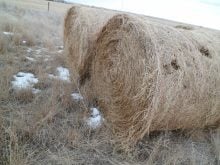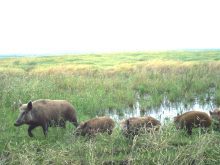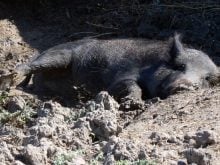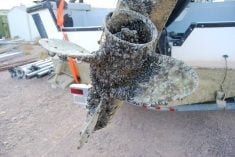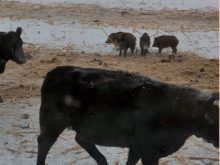Copying U.S. strategies has not worked in Canada because the northern pigs act differently than their southern cousins
HOLLAND, Man. — Manitoba’s rugged wild pigs ain’t like the pampered porkers down south.
That means finding, trapping, controlling and monitoring them can’t be done in the same way that Texans do it.
As millions of people have seen on YouTube, Texans and other southern plains humans have become adept at trapping large numbers of feral pigs. They use big drop-gate traps, operated by electronic systems connected to trail cameras, to catch groups of dozens of the giant porkers.
Manitoba’s wild pig fighters tried that system.
“We were seeing that didn’t work,” said Devon Baete, Squeal on Pigs (Manitoba) field operations manager, during a recent visit to some of the organization’s trapping sites in the Spruce Woods region. (The exact locations are being kept secret in order to avoid drawing pig-hunters to the farms and ranches that are grappling with wild pig problems. Random shooting of pigs tends to just scatter the rest of the sounder to other areas and spread the problem.)

The electronic drop-gate experiment failed in Manitoba due to both Manitoba and Manitoba wild pigs realities.
“We realized with our colder weather, they just freeze up,” said Baete.
Also, the remotely operated U.S. systems require three batteries to run the cameras and the gate, as well as good cellular service, none of which work well in remote pig-haunted regions of Manitoba.
Plus, Manitoba wild pigs don’t act like the southern ones. Large groups of Texas pigs, for instance, can be easily lured into big traps with piles of corn on the ground.
“They’re just used to eating corn, something that’s been fed to them,” said Baete.

The baited-hunting industry is big in parts of the southern Plains, so the pigs have grown accustomed to provided feed. That’s not true up north.
In Manitoba, a couple of pigs might show up one night to check out a baited trap, then none be seen there for weeks. Manitoba pigs appear to move in small groups, are furtive and focus on natural feed sources and standing crops. That makes trap siting a challenge.
Manitoba’s pig fighters look for signs of depredation — dug-up edges to fields, particularly — as well as pig trails, when considering where to set up traps.

Drop gates have been adapted to operate mechanically, with no electronic component, triggered by pigs rooting around in the baited feed.
Net traps are designed to allow the pigs to get in, then get stuck inside. Cameras on trees peering down on both types of traps allow pig fighters to see if anything has become caught.
Wild pigs are a problem across Western Canada, arising from the escape and release of wild boars in the 1980s and 1990s, escaped domestic barn pigs and field pigs that have been allowed to roam. A wicked hybrid has developed, with wild sows now able to deliver litters of up to 10 piglets, which is close to commercial levels and far higher than the Eurasian wild boar can achieve.

The war against the pigs is happening across the Prairies. It’s mostly carried out in bush country, on the edges of fields near wildlands, in areas where people are few but conditions are ideal for wild pigs. Farmers are on the front lines of this struggle, suffering damage to pastures, crops and livestock from the aggressive beasts.
The pigs have been spreading for years. The main human efforts against this incursion are just beginning. Nobody expects this war to end soon.






